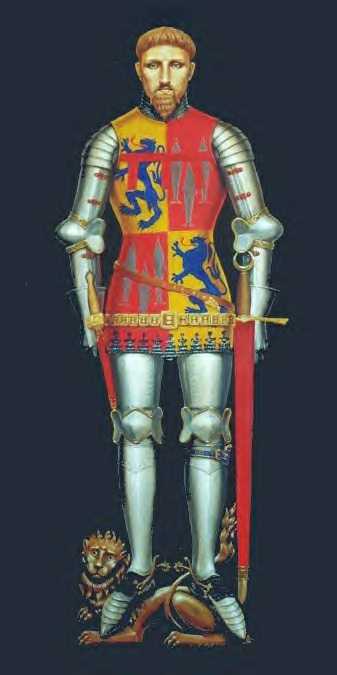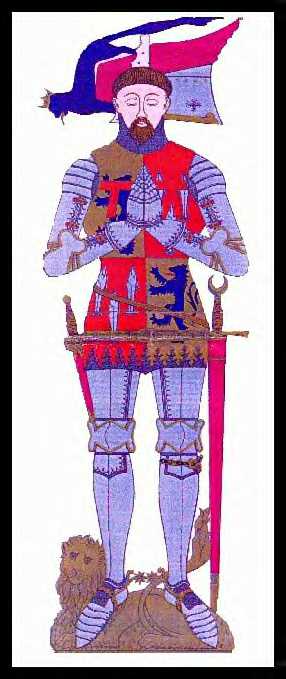A couple of months ago, I was approached by a friend of mine, who is one of the most dedicated Medieval re-enactors in Bulgaria, with a request for making a dagger for him.
My work was based on the top-most original
[ Linked Image ]
and this replica, made by un-known to me craftsman
[ Linked Image ]
It was a pleasent journey while making this dagger - particularly I've never encountered crescent-shaped pommels so far.
Additionally, it was quite challenging to work on the customer's request - so far I've always worked keeping my own plan. Now I had to change this manner of work and to do the job, complying with the owner's wishes (which changed or evolved in the course of the working proccess).
Already finished, the dagger looks like that
[ Linked Image ]
[ Linked Image ]
As my friend re-enacts an European knight, settled in the Outremer after pilgrimage, we have the appropriate Jerusalem Cross on the scabbard
[ Linked Image ]
The idea for the chess-board laced leather straps was taken from one of Mr. Leo Todeshini's works. Thanks, Tod!!!
The blade has a very short ricaso, narrow fullers on both sides and pentagonal cross-section almost to the end of the fullers. After that the cross-section gradually changes to flat diamond. Although the sanding is not exreme (this time I did it only to grit #600), the polishing is good - this was the result of working with three (not just two as usual) polishing compounds, first one of which being very rude.
Some pictures of the blade
[ Linked Image ]
[ Linked Image ]
[ Linked Image ]
I really like this one - the dagger crossed with scabbard (BTW, this time the chape was made from brass - thus matching in colour with the hilt)
[ Linked Image ]
And some pictures of the hilt
[ Linked Image ]
[ Linked Image ]
[ Linked Image ]
[ Linked Image ]
One particular moment I really don't like in this work, is this
[ Linked Image ]
I didn't manage to sand the outer surfaces of the tang to even steel-grey colour without seriously harming the wood of the grip - thus leaving some areas still black.
Also note two thin (0.5 mm) brass plates, placed between the tang and both scales.
Closer to the grip - the wood is walnut soaked with wax, rivets are steel in copper tubes, brass insertions in the middle of the carved "flowers"
[ Linked Image ]
[ Linked Image ]
And finally - some stats (only for the dagger, w/o the scabbard):
* total length - 449 mm
** blade length - 305 mm
*** blade width (at the guard) - 30 mm
**** blade thickness - 5 mm at the guard, gradually tapering to 2.7 mm at 20 mm from the tip
***** mass - 420 gr
****** steel - leaf-spring 65G, hardness about 58-60 HRC
[ Linked Image ]
[ Linked Image ]
[ Linked Image ]
[ Linked Image ]
One particular moment I really don't like in this work, is this
[ Linked Image ]
I didn't manage to sand the outer surfaces of the tang to even steel-grey colour without seriously harming the wood of the grip - thus leaving some areas still black.
Also note two thin (0.5 mm) brass plates, placed between the tang and both scales.
Closer to the grip - the wood is walnut soaked with wax, rivets are steel in copper tubes, brass insertions in the middle of the carved "flowers"
[ Linked Image ]
[ Linked Image ]
And finally - some stats (only for the dagger, w/o the scabbard):
* total length - 449 mm
** blade length - 305 mm
*** blade width (at the guard) - 30 mm
**** blade thickness - 5 mm at the guard, gradually tapering to 2.7 mm at 20 mm from the tip
***** mass - 420 gr
****** steel - leaf-spring 65G, hardness about 58-60 HRC
Hello Boris
The replica you show by another is the Del Tin pugnale secolo XIII / 13th Century dagger.
http://www.deltin.it/2134.htm
Somewhere in Oakeshott's The Archaeology of Weapons a dagger there is mentioned and I believe the inspiration for these reproductions. There is this article as well mentioning the 13th century.
http://www.docstoc.com/docs/52300359/A-mediev...Perthshire
Also worth mentioning but an extant sword has never surfaced associated with Percy, Harry Percy is said to have had a crescent pommel sword (ca 1400).
Cheers
GC
.
 Attachment: 19.5 KB
Attachment: 19.5 KB

 Attachment: 29.43 KB
Attachment: 29.43 KB

The replica you show by another is the Del Tin pugnale secolo XIII / 13th Century dagger.
http://www.deltin.it/2134.htm
Somewhere in Oakeshott's The Archaeology of Weapons a dagger there is mentioned and I believe the inspiration for these reproductions. There is this article as well mentioning the 13th century.
http://www.docstoc.com/docs/52300359/A-mediev...Perthshire
Also worth mentioning but an extant sword has never surfaced associated with Percy, Harry Percy is said to have had a crescent pommel sword (ca 1400).
Cheers
GC
.


Very nice work, as usual, and I really like the flowers in the handle and the file work on pommel and guard.
The blade has a very practical design of a short false edge for a mostly single edged dagger I assume based on an original blade, but in any case a very good fighting knife blade.
I also like the scabbard. :D :cool:
The blade has a very practical design of a short false edge for a mostly single edged dagger I assume based on an original blade, but in any case a very good fighting knife blade.
I also like the scabbard. :D :cool:
Itīs really nice, Boris - from a not-so-usual pommel, to a blade with very interesting geometry. May I ask how you did the pommel? Is it cast, or was it cut from a large bass disc? Thank you - and kudos for you work!
Great! I love that dagger! The pommel is really nicely done. I like the grip the best though! The alternating rivet colors and the decorative elements to the wood really match the pommel and grip and add the perfect amount of detail!
Thanks a lot, friends!
These kind words are your real assessment of my work.
# Glen
I knew I'm familiar with this style of photography - really Del Tin often take pictures of their items placed on red velvet.
I know this article also, but anyway - thanks for sharing with us. May be it could be useful for someone else from the community.
# Radovan
The pommel was neither cast or cut. It was turned on lathe using "secret" :cool: technique - "off-center" turning.
Well, what I mean?
When I turn a round bar in normal way (the bar is simply placed in the chuck and all its jaws clamp the bar in uniform manner) what I get as a resulting shape is a tube - one big, beautiful and round letter "O".
When using the "off-center" turning technique I place a pad between the bar and one of the jaws of the chuck. The pad in the case are number of steel lamelae. Thus, the center efectively shifts from the center of the bar (as where it would be in the normal turning) towards the jaw with the pad; the amount of this shift is equal with the thickness of the pad. The rest is simple calculatind of the pad/shift, some test turning and proper turning of the piece.
As a result I get some deformed tube - the wall closer to the jaw with the pad is the thinnest, while the oposite one - thickest (this is the thickest part of the pommel in the area of the grip).
The rest, of course, includes some cutting and filing - until I get the crescent shape you see.
These kind words are your real assessment of my work.
# Glen
I knew I'm familiar with this style of photography - really Del Tin often take pictures of their items placed on red velvet.
I know this article also, but anyway - thanks for sharing with us. May be it could be useful for someone else from the community.
# Radovan
The pommel was neither cast or cut. It was turned on lathe using "secret" :cool: technique - "off-center" turning.
Well, what I mean?
When I turn a round bar in normal way (the bar is simply placed in the chuck and all its jaws clamp the bar in uniform manner) what I get as a resulting shape is a tube - one big, beautiful and round letter "O".
When using the "off-center" turning technique I place a pad between the bar and one of the jaws of the chuck. The pad in the case are number of steel lamelae. Thus, the center efectively shifts from the center of the bar (as where it would be in the normal turning) towards the jaw with the pad; the amount of this shift is equal with the thickness of the pad. The rest is simple calculatind of the pad/shift, some test turning and proper turning of the piece.
As a result I get some deformed tube - the wall closer to the jaw with the pad is the thinnest, while the oposite one - thickest (this is the thickest part of the pommel in the area of the grip).
The rest, of course, includes some cutting and filing - until I get the crescent shape you see.
very ingenious:) thank you for sharing this secret :)
Page 1 of 1
You cannot post new topics in this forumYou cannot reply to topics in this forum
You cannot edit your posts in this forum
You cannot delete your posts in this forum
You cannot vote in polls in this forum
You cannot attach files in this forum
You can download files in this forum
All contents © Copyright 2003-2006 myArmoury.com — All rights reserved
Discussion forums powered by phpBB © The phpBB Group
Switch to the Full-featured Version of the forum
Discussion forums powered by phpBB © The phpBB Group
Switch to the Full-featured Version of the forum